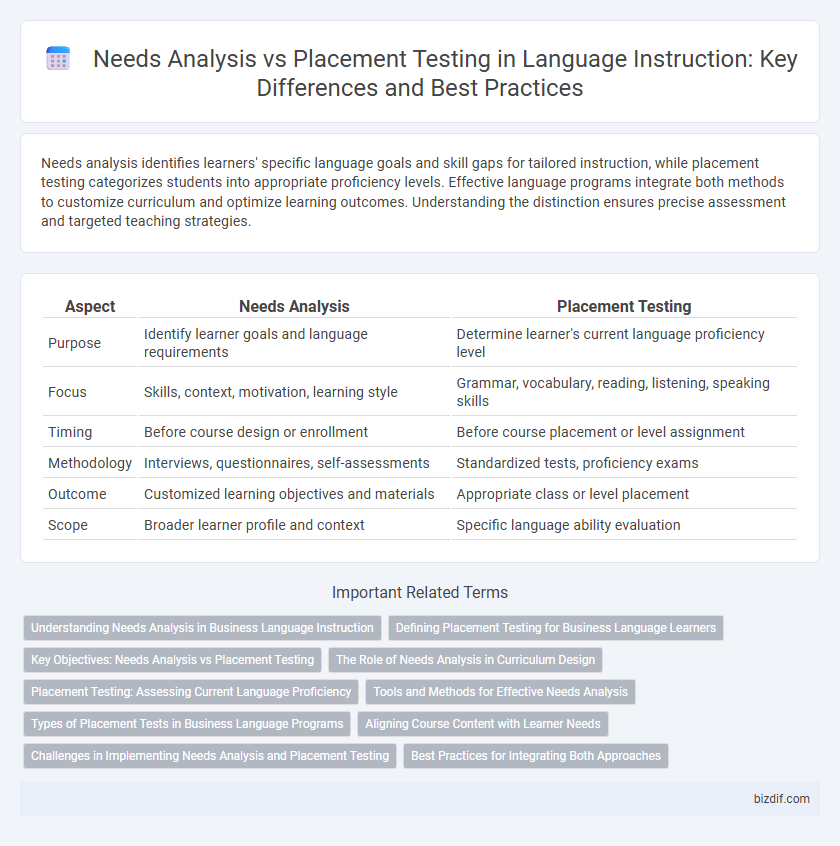Needs analysis identifies learners' specific language goals and skill gaps for tailored instruction, while placement testing categorizes students into appropriate proficiency levels. Effective language programs integrate both methods to customize curriculum and optimize learning outcomes. Understanding the distinction ensures precise assessment and targeted teaching strategies.
Table of Comparison
| Aspect | Needs Analysis | Placement Testing |
|---|---|---|
| Purpose | Identify learner goals and language requirements | Determine learner's current language proficiency level |
| Focus | Skills, context, motivation, learning style | Grammar, vocabulary, reading, listening, speaking skills |
| Timing | Before course design or enrollment | Before course placement or level assignment |
| Methodology | Interviews, questionnaires, self-assessments | Standardized tests, proficiency exams |
| Outcome | Customized learning objectives and materials | Appropriate class or level placement |
| Scope | Broader learner profile and context | Specific language ability evaluation |
Understanding Needs Analysis in Business Language Instruction
Needs analysis in business language instruction identifies specific communication goals, workplace tasks, and linguistic challenges faced by professionals, ensuring tailored curriculum development. This approach prioritizes understanding target audience requirements and contextual language use over merely determining proficiency levels, which is the focus of placement testing. Effective needs analysis enhances learner motivation and outcomes by aligning instruction with real-world business scenarios and objectives.
Defining Placement Testing for Business Language Learners
Placement testing is a diagnostic tool designed to evaluate business language learners' current proficiency levels, ensuring they are assigned to instruction programs that match their skill sets. It measures specific language competencies such as vocabulary, grammar, and communication skills relevant to professional contexts. Accurate placement testing enhances training efficiency by targeting learners' needs and accelerating progress in business communication.
Key Objectives: Needs Analysis vs Placement Testing
Needs analysis identifies learners' specific language goals, proficiency gaps, and contextual requirements to tailor curriculum and instructional strategies effectively. Placement testing evaluates existing language proficiency levels to categorize learners into appropriate proficiency groups for optimized class assignment. Both processes ensure optimal learning pathways but differ in focus: needs analysis targets personalized learning objectives, while placement testing emphasizes initial skill assessment.
The Role of Needs Analysis in Curriculum Design
Needs analysis plays a critical role in curriculum design by identifying learners' specific language goals, proficiency levels, and contextual requirements, ensuring tailored instructional content. It collects qualitative and quantitative data through interviews, questionnaires, and observations to create targeted learning outcomes. This process enhances curriculum relevance and effectiveness by aligning materials and activities with the learners' immediate and long-term communicative needs.
Placement Testing: Assessing Current Language Proficiency
Placement testing evaluates current language proficiency by accurately measuring a learner's existing skills in reading, writing, listening, and speaking. This data-driven approach ensures that individuals are assigned to language courses that match their actual competence level, optimizing learning efficiency. Unlike needs analysis, placement testing focuses exclusively on assessing language abilities rather than identifying learner goals or motivations.
Tools and Methods for Effective Needs Analysis
Effective needs analysis in language instruction employs tools such as surveys, interviews, and observation checklists to gather detailed learner information. Methods like task-based assessments and learner self-assessments provide qualitative data to identify specific language goals and proficiency gaps. These approaches ensure tailored curriculum design by precisely addressing learners' strengths, weaknesses, and contextual learning requirements.
Types of Placement Tests in Business Language Programs
Placement tests in business language programs typically include proficiency-based assessments, diagnostic tests, and situational judgment tests, each designed to evaluate specific linguistic skills relevant to professional contexts. Proficiency-based tests measure overall language ability through reading, writing, listening, and speaking components aligned with the Common European Framework of Reference for Languages (CEFR) levels. Diagnostic tests identify particular strengths and weaknesses in business communication, while situational judgment tests assess decision-making and language use in real-world corporate scenarios.
Aligning Course Content with Learner Needs
Needs analysis identifies learners' specific language goals, strengths, and weaknesses through surveys, interviews, and diagnostic tasks to tailor course content effectively. Placement testing determines learners' proficiency levels, ensuring appropriate class grouping but may overlook individual learning objectives and preferences. Aligning course content with learner needs requires integrating insights from both methods to create personalized and relevant language instruction.
Challenges in Implementing Needs Analysis and Placement Testing
Challenges in implementing needs analysis include accurately identifying learner goals and accommodating diverse linguistic backgrounds, which often lead to incomplete data collection and hinder personalized instruction. Placement testing faces difficulties such as test anxiety affecting performance, mismatched test content with actual course objectives, and limited scope in assessing comprehensive language skills. Both processes require continuous refinement to ensure valid, reliable, and meaningful placement and course design outcomes in language instruction.
Best Practices for Integrating Both Approaches
Combining needs analysis and placement testing enhances language instruction by accurately identifying learners' goals and proficiency levels. Effective integration involves using placement test results to inform a personalized needs analysis, ensuring targeted curriculum development. Implementing ongoing feedback mechanisms between both approaches maximizes learner engagement and instructional relevance.
Needs Analysis vs Placement Testing Infographic

 bizdif.com
bizdif.com